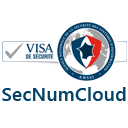There are several ways to deploy videoconferencing within an organization. Whether it’s in the public cloud, private cloud, or an on-premise solution, each deployment meets a specific need and has its own advantages.
Definition of Cloud-Based Videoconferencing Software
Cloud-based videoconferencing software refers to a communication solution hosted on remote servers managed by an external provider.
These servers are accessible online, allowing users to access the solution with just an Internet connection.
What is the difference with an on-premise videoconferencing solution?
On-premise videoconferencing software is installed and operates on a company’s own servers and IT infrastructure. Access to internally stored data is not constrained by an Internet connection for internal communications.
On-premise or cloud: Identifying the Need
Easily Deploying Videoconferencing
For small or medium-sized businesses needing a videoconferencing solution to be deployed quickly and cost-effectively, the cloud is the most suitable. Indeed, public cloud videoconferencing does not require the installation of a server, allowing for the optimization of allocated resources. Additionally, its quick deployment can be appreciated: within a few hours, the service is fully operational.
Having Your Own Cloud Videoconferencing Server
For medium to large organizations with a bigger budget and prioritizing deployment simplicity, private cloud videoconferencing stands out. It offers the benefits of the cloud while allowing the company to have its own videoconferencing server. Organizations can also obtain their own cloud server address. Some providers also allow for the customization of the user interface to match the company’s branding.
Opting for Maximum Security
For large and very large enterprises with stringent cybersecurity requirements, installing and managing a videoconferencing server within their own network infrastructure might be preferred over relying on a cloud provider. Therefore, deploying an on-premise videoconferencing solution will be more suitable.
The Advantages of Cloud-Based vs. On-Premise Videoconferencing
Flexibility and Scalability
Cloud-based videoconferencing easily adapts to the number of users of the solution. For online meetings with a few collaborators or large videoconferences, the solution can be scaled without incurring significant costs, unlike modifications on proprietary servers. Moreover, cloud-based videoconferencing does not require the implementation of IT infrastructure or maintenance by the companies.
Customization of the Interface
Although it is not as technically customizable as an on-premise solution, the private cloud videoconferencing server can be graphically customized. This is the case with the TixeoPrivateCloud offer. Companies can customize the software interface and web access with their colors and logo. Emails sent by Tixeo (meeting invitations, updates, etc.) are also personalized to reflect their branding. During meetings, a watermark text can be added at the bottom right to convey a confidentiality message (e.g., “restricted distribution”).
Ease of Maintenance
The cloud videoconferencing solution provider handles security updates, software improvements, and server maintenance. This reduces the workload for the company’s IT teams and thus limits costs.
Cost Reduction

In addition to resource savings, the subscription model for cloud videoconferencing typically allows companies to adjust their pricing plan according to their current needs. This enables them to achieve cost savings and gain agility.
Tixeo offers its secure, certified, and ANSSI-qualified videoconferencing solution in the public cloud. Hosted in France, with a customized and high-performance offer that optimizes operating costs.
In France: The State Places “Cloud at the Center”
The “cloud at the center” doctrine, promoted by the French government, encourages public administrations to rely on cloud-hosted digital services. To accelerate the digitalization of public services, this widespread adoption of the cloud must ensure data security. This requires choosing sovereign providers qualified as SecNumCloud (or holding a European qualification to guarantee an equivalent level, particularly in cybersecurity).
Public Administrations: Protect Your Communications
The SecNumCloud Qualification
SecNumCloud is a security qualification offered by ANSSI that guarantees a high level of security for cloud computing operators and clients. It serves as a selection criterion to ensure the security of cloud software.
To benefit from this, the cloud provider must prove compliance with the best practices and security standards listed in the SecNumCloud framework. Once received, the qualification is akin to a recommendation for the use of the service by the French State.
The Higher Commission for Digital and Postal Services (CSNP) has recently called for extending the obligations to host sensitive data in a sovereign cloud to all administrations, in line with the NIS 2 Directive.
Tixeo offers its secure, certified, and ANSSI-qualified videoconferencing solution in a private, sovereign cloud, qualified SecNumCloud.
Découvrir l’offre TixeoPrivateCloud qualifié SecNumCloud


The Advantages of On-Premise vs. Cloud Videoconferencing
Companies opt for this type of deployment for reasons of compliance, data security, or the need for specific features not available in cloud solutions.
Total Control of the Solution
By deploying on-premise videoconferencing software, the organization has complete control over its IT infrastructure. It becomes responsible for the maintenance and updates of the solution and the necessary software to run the service.
Ensuring Business Continuity
Thanks to its offline operation, on-premise videoconferencing allows organizations to maintain communications. It thus ensures business continuity in case of a crisis, internet connection outage, or IT failure.
Technological Independence
Deploying your own videoconferencing server strengthens your technological independence and sovereignty. Indeed, some cloud-based videoconferencing solutions adhere to extraterritorial regulations that provide limited protection for user data. With on-premise videoconferencing, the company limits security breaches and relies on its own expertise, without external intervention.
Maintaining Control over Personal Data Processing
By adopting the on-premise model, the company retains absolute control over the processing of its users’ personal data. This avoids entrusting the data to a third party and minimizes the risk of data leaks. Consequently, the organization can easily ensure its compliance with GDPR.
Further information : What is on-premise videoconferencing software?
Tixeo offers its secure, certified, and ANSSI-qualified videoconferencing solution in an on-premise version for maximum security during integration.


FAQ :
An On-Premise solution is installed and hosted on the company’s internal servers, providing the organization with full control over data and security.
Cloud solutions offer increased flexibility, automatic updates, and do not require dedicated hardware infrastructure. They also allow easy access for users from any location.
An On-Premise solution is ideal for companies with strict security and data privacy requirements that prefer to maintain full control over their infrastructure.
Cloud solutions can pose data protection risks if they are not sovereign. Therefore, choosing a SecNumCloud-qualified solution is recommended.
The choice depends on several factors, such as security needs, available resources for infrastructure management, required flexibility, and the company’s budget.
On-Premise solutions involve higher initial costs for hardware and installation, while Cloud solutions typically operate on a subscription model with costs spread over time.
On-Premise solutions require an IT team to manage maintenance, updates, and backups, which can represent significant cost and time investments.
Cloud solutions enable real-time collaboration and easy access to meetings from various devices and locations, facilitating remote work.
Cloud solutions can be vulnerable to cyberattacks if adequate security measures are not implemented, such as data encryption and strict access management.
Yes, Tixeo offers both On-Premise and Cloud videoconferencing solutions, sovereign and tailored to meet the specific security and flexibility needs of businesses.

